

Where the Calorie Myths Came From
One way to clear up all the calorie confusion is to start at the beginning and look at the history of eating using a scale of one day. Say 12:00 a.m. was the dawn of our first ancestors and right now it’s one second before midnight. Up until 11:57 p.m. our ancestors stayed healthy and fit, eating only what could be found directly in nature—vegetables, seafood, meat, eggs, fruits, nuts, and seeds. At 11:57 p.m. people started farming, became “civilized,” and began eating starch and a small amount of sweets. Two seconds ago, people started eating processed starches and sweets. Only right now—one second before midnight—did people start getting most of their calories from genetically modified and highly manufactured starch- and sweetener-based edible products.
That means the diet recommended by the government’s Dietary Guidelines was not possible—forget about healthy or slimming—for 99.8 percent of our history. Our ancestors did not hunt or gather pasta, rice, cereal, or bread. They did not eat whole grains. They ate no grains. They did not cut back on added sweeteners. They did not know what added sweeteners were. Emory University anthropologist S. Boyd Eaton, MD, tells us, “During the late Paleolithic [the vast majority of human history], the great majority of carbohydrates was derived from vegetables and fruit, very little from cereal grains and none from refined flours.”85
This idea is interesting to think about when it comes to our health. Obesity, diabetes, and heart disease are called “diseases of civilization.” They did not become issues until agriculture enabled production of starches and sweets about twelve thousand years ago. They did not reach epidemic status until starches and sweets became highly processed, were genetically modified, and made up most of our diet. Colorado State University researchers found that a whopping 72 percent of what we eat today was not eaten for at least 99.8 percent of our evolutionary history.86*
How Much of Today’s Typical Diet Is Not Natural?
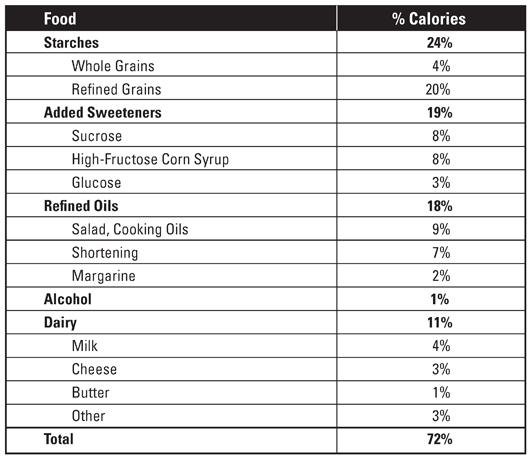
The diet we evolved to eat has been flipped on its head. Is it any wonder our health and fitness have been flipped on their heads as well? Over 70 percent of our diet is made up of unnatural food. Over 70 percent of us have unhealthy and inflated waistlines. Coincidence or common sense?
Of course, some people might object: “Back then, people didn’t live as long as we do now.” That is an excellent point. I felt the same way until I discovered research that reveals three facts about hunter-gatherers:
1. They are few and far between today, but hunter-gatherer tribes are still around, and scientists have studied them intensively. The studies show that they are free from obesity, diabetes, and heart disease.
2. While their average age of death is lower than ours, many ancient hunter-gatherers lived beyond the age of sixty. Back to Dr. S. Boyd Eaton: “Occasionally one hears the claim that primitive people all died too young to get degenerative diseases. This claim is simply false—many lived well into and through the age of vulnerability for such disorders, yet didn’t get them.”87
3. Let’s take old age out of the equation entirely. Obese and type 2 diabetic “civilized” children are running around all over the place. The children of hunter-gatherers were free of obesity and diabetes.
It’s not a coincidence that the decline in the quality of our food has coincided with the decline in the quality of our health. We are not designed to digest the majority of foods we’re being told to eat. Walter Willett, chair of the Harvard School of Public Health, states unequivocally, “The USDA Pyramid is wrong. It was built on shaky scientific ground . . . [and] has been steadily eroded by new research from all parts of the globe. . . . At best, [it] offers wishy-washy, scientifically unfounded advice.”88 The Journal of the American College of Cardiovascular Exerciselogy makes this connection: “The low-fat-high-carbohydrate diet, promulgated vigorously by the . . . food pyramid, may well have played an unintended role in the current epidemics of obesity . . . diabetes, and metabolic syndromes.”89 Michael F. Jacobson, the cofounder of the Center for Science in the Public Interest, offers a blunt assessment: “Good advice about nutrition conflicts with the interests of many big industries, each of which has more lobbying power than all the public-interest groups combined.”90
THE SOURCE OF OUR WEIGHT PROBLEMS
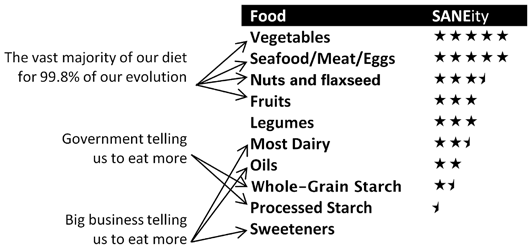
Decades of advanced dietary research have taken place alongside spiking obesity and disease rates. This research recommends a diet much different from any version of the government’s Dietary Guidelines. For example, Marion Nestle, PhD, MD, professor of nutrition, food studies, and public health at New York University, notes how the scientific community has long criticized the USDA’s Food Guide Pyramid’s failure to recognize that sugar and starch are biochemically equivalent within the body. Starch has the same impact on our body as sugar, says Donald Layman, PhD, professor of nutrition at the University of Illinois. “All starches from all of the grains are simply a long chain of simple sugars connected together. The term complex carbohydrate just means a long chain of sugars. As soon as a food is digested and absorbed, the body does not know the difference between a simple sugar and a whole grain.”91
Why don’t the government’s guidelines reflect this research? Why is a food that is “biochemically equivalent” to sugar recommended in mass quantities?92
A great deal of money is being made from our nutritional confusion. The history of the USDA guidelines and graphics is nothing short of shocking.
POLITICIANS PLAYING PHYSICIANS
Detailing the disturbing history of the government’s role in our diet would take an entire book. If you would like to find out the whole story, you can read an excellent book called Good Calories, Bad Calories by Gary Taubes. Here is the short version.
The original release of the government’s Dietary Guidelines for Americans—and subsequent Food Guide Pyramid and MyPlate graphics—came about because certain politicians were playing physicians. Harvard School of Public Health Professor Walter Willett, MD, PhD, MPH, notes: “Some recommendations on diet and nutrition are misguided because they are based on inadequate or incomplete information. That hasn’t been the case for the USDA’s pyramids. They are wrong because they brush aside evidence on healthful eating that has been carefully assembled over the past forty years.”93 In the Journal of American Physicians and Surgeons, public health scientist Alice Ottoboni, PhD, adds: “There is considerable concern today that the diet the Pyramid illustrates is responsible for the current epidemic of cardiovascular disease. The concurrent epidemics of obesity and type-2 diabetes are unintended consequences that can also be attributed to this diet.”94
How did the government come up with these dietary guidelines? In 1980, when the guidelines were first introduced, scientists did not have a good understanding of what would happen if most people adopted these guidelines. The dietary guidelines and graphics were not drawn up by nutrition scholars. They were derived from a political document released in 1976 called Dietary Goals for the United States.* Dietary Goals was designed by the Senate Select Committee on Nutrition and Human Needs to do two things. The first was to increase carbohydrate consumption to account for 55 percent to 60 percent of calorie intake. The second was to reduce overall fat consumption from 40 percent to about 30 percent of calorie intake.
These goals and the rest of the document are more speculative than scientific. Dr. Stewart Truswell, professor in the School of Molecular Bioscience at the University of Sydney, tells us, “The first edition of Dietary Goals. . . took nutritionists by surprise. . . . [It] was written by a group of politically interested activists with small knowledge of nutrition. . . . The collected objections can be summarized very briefly: Too soon, more research needed, relationships not proved; politically motivated.”95 Even the American Medical Association was worried when Dietary Goals was released, lamenting the potentially harmful effects of such a radical long-term dietary change. Scientists at the University of Wisconsin–Madison called the goals report “not scientifically sound,” referring to it as “a political and moralistic document.”96
Perhaps the most telling objection came from the president of the National Academy of Sciences in his testimony to the Senate in regard to Dietary Goals: “What right has the federal government to propose that the American people conduct a vast nutritional experiment, with themselves as subjects, on the strength of so very little evidence that it will do them any good?”97
But although Dietary Goals was unproved and controversial among the scientific community, the government declared it “the truth” on these grounds: “We [the government] live in the present and cannot afford to await the ultimate proof before correcting trends we believe to be detrimental.”98 With that uneducated guess, a low-fat, low-protein, high-starch diet was declared “healthy.” Sadly, the results have been anything but.
To understand why the Senate Nutrition Committee gave us these dietary goals in the first place, we have to go back a few more decades. One man single-handedly convinced the country that natural foods are deadly.
PERCENT OF AMERICANS AT LEAST OVERWEIGHT
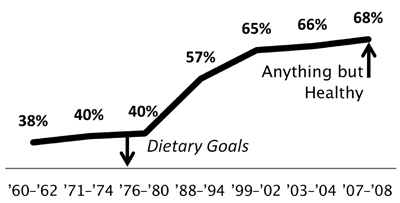
MILLIONS OF AMERICANS WITH DIABETES
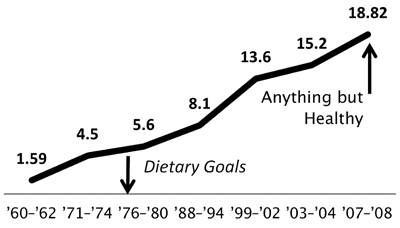
MILLIONS OF HOSPITAL DISCHARGES FOR CARDIOVASCULAR DISEASES IN THE US
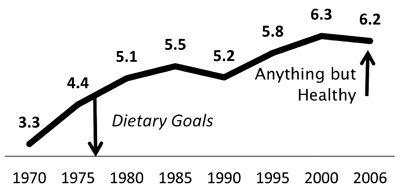
MILLIONS OF NONFATAL HEART DISEASE INCIDENTS IN THE US
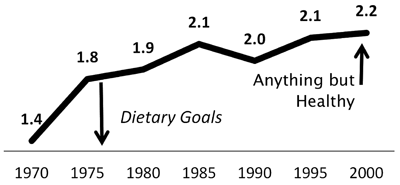
FAT FICTION
In the 1950s Ancel Keys examined diet and heart disease trends in twenty-two countries. He was apparently more interested in headlines than science because he then published a study that included data from only the six countries that showed a frightening link between dietary fat and heart disease. Keys garnered a massive amount of press and then went on tour armed with the message that eating fat is deadly.
HEART DISEASE DEATHS PER 1,000 MEN
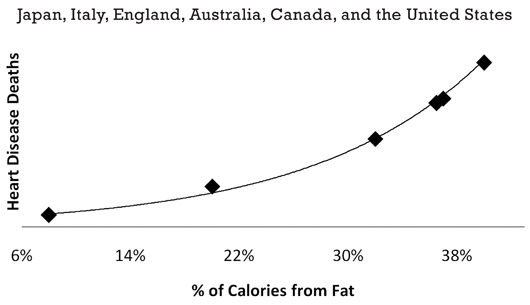
Here are the facts: When the data from all twenty-two countries in Keys’s study are examined, they show no relationship between dietary-fat intake and heart disease deaths. Keys selectively picked data and designed a headline-worthy conclusion. In the words of a fellow researcher, “No information is given by Keys on how or why the six countries were selected.”99 Further exposing the randomness of Keys’s methods, those same researchers revealed that by selectively choosing six different countries from Keys’s data, they could create a graph suggesting that eating more fat decreases the risk of dying from heart disease.
Finally, looking at Keys’s data a few years later, they concluded, “The examination of all available basic data . . . show[s] that the association [between fat and heart disease] lacks validity.”100 They also discovered “a strong negative association . . . for both animal protein and fat with mortality from non-cardiac diseases.” Even the American Medical Association spoke up in protest: “The anti-fat, anti-cholesterol fad is not just foolish and futile . . . it also carries some risk.” No matter. The “fat is evil” myth started a nationwide campaign to replace natural foods containing fat with fat-free products and climaxed with the government’s Dietary Guidelines, Food Guide Pyramid, MyPyramid, and MyPlate diets. Those diets are high in starch because starch is low in fat. Unfortunately, over a billion dollars’ worth of studies have failed to prove that the government’s guidelines are good for anything other than profits.
HEART DISEASE DEATHS PER 1,000 MEN
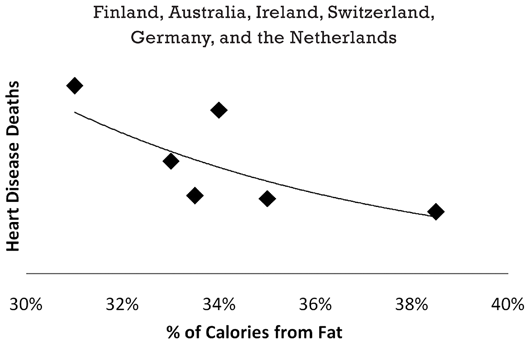
Harvard Medical School’s position on the government’s eating guidelines is unambiguous: “Few public health messages are as powerful and as persistent as this one: Fat is bad. . . . The average American has substantially reduced the percentage of calories that she or he gets from fat over the past three decades. . . . But we are not any healthier for all of this effort. In fact, we are worse off for it.”101 Numerous studies have have been unable to find a link between dietary fat and heart disease.
When Patty W. Siri-Tarino, PhD, of the Children’s Hospital & Research Center in Oakland, examined twenty-one studies that included a total of 347,747 people, he found, “There is no significant evidence for concluding that dietary saturated fat is associated with an increased risk of heart disease or cardiovascular disease.”102 The National Heart, Lung, and Blood Institute funded an enormous trial designed to link the consumption of foods containing fat to heart disease. The $115 million Multiple Risk Factor Intervention Trial took 12,866 men with high cholesterol, split them into two groups, and fed one group the government guidelines’ diet for seven years with the hope of lowering the incidence of heart disease. The government’s diet resulted in a 7.1 percent increase in heart disease deaths.103
The Women’s Health Initiative of the National Institutes of Health completed a $700 million study to test the fat hypothesis. A whopping 48,835 women ate their normal diet or the government diet for about eight years. At the end of the study, the regular- and government-diet women weighed the same and no differences were found in their health. The researchers concluded, “Dietary intervention that reduced total fat intake did not significantly reduce the risk of coronary heart disease, stroke, or cardiovascular disease.”104 As reported in the study: “[This] trial is the largest long-term randomized trial of a dietary intervention ever conducted to our knowledge, and it achieved an 8.2 percent reduction . . . in total fat intake. . . . No significant effects on incidence of coronary heart disease or stroke were observed.” On February 8, 2006, the New York Times ran the headline: LOW-FAT DIET DOES NOT CUT HEALTH RISKS, STUDY FINDS.
A massive study named MONICA involved 113 groups of scientists and doctors in twenty-seven countries studying everything they thought could contribute to heart disease. They found little if any association between the average cholesterol level and heart-related mortality. In the Western Electric Study—known in academic circles as one of “the most informative prospective studies to date”—researchers concluded, “Although the focus of dietary recommendations is usually a reduction of saturated fat intake, no relation between saturated fat intake and risk of coronary heart disease was observed [in their study].”105
The government was trying to help with the guidelines but, sadly, it failed. Harvard Medical School Professor of Medicine Frank Hu, MD, MPH, PhD, tells us, “It is now increasingly recognized that the low-fat campaign has been based on little scientific evidence and may have caused unintended health consequences.”106 Even worse, the horrible health consequences continue. Researchers know it and the data show it. In the next chapter, we’ll look at the confusion at the heart of the low-fat and low-cholesterol myths.
It’s All about Results: A Pragmatism Primer
Pragmatists are results-oriented—they believe something is right or wrong based on its results. People can try anything they want and the true worth of the program is revealed by its results. If it works, it is right. If it fails, it is wrong.